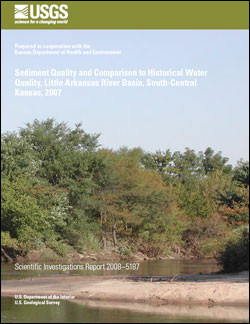
Product Details
- Product Number
- 229376
- Series
- SIR-2009-5182
- Scale
- NO SCALE
- Alternate ID
- SIR-2009-5182
- Authors
- JERROD S SMITH
- Version Date
- 01/01/2010
- Regions
- OK
- Countries
- USA
- Media
- Paper
- Format
- Bound
- Digital Reproduction
- Yes
Additional Details
- Description
- Abstract The quality of streams in the Illinois River Basin of northeastern Oklahoma is potentially threatened by increased quantities of wastes discharged from increasing human populations, grazing of about 160,000 cattle, and confined animal feeding operations raising about 20 million chickens. Increasing numbers of humans and livestock in the basin contribute nutrients and bacteria to surface water and groundwater, causing greater than the typical concentrations of those constituents for this region. Consequences of increasing contributions of these substances can include increased algal growth (eutrophication) in streams and lakes; impairment of habitat for native aquatic animals, including desirable game fish species; impairment of drinking-water quality by sediments, turbidity, taste-and-odor causing chemicals, toxic algal compounds, and bacteria; and reduction in the aesthetic quality of the streams. The U.S. Geological Survey, in cooperation with the Oklahoma Scenic Rivers Commission, prepared this report to summarize the surface-water-quality data collected by the U.S. Geological Survey at five long-term surface-water-quality monitoring sites. The data summarized include major ions, nutrients, sediment, and fecal-indicator bacteria from the Illinois River Basin in Oklahoma for 1970 through 2007. General water chemistry, concentrations of nitrogen and phosphorus compounds, chlorophyll-a (an indicator of algal biomass), fecal-indicator bacteria counts, and sediment concentrations were similar among the five long-term monitoring sites in the Illinois River Basin in northeast Oklahoma. Most water samples were phosphorus-limited, meaning that they contained a smaller proportion of phosphorus, relative to nitrogen, than typically occurs in algal tissues. Greater degrees of nitrogen limitation occurred at three of the five sites which were sampled back to the 1970s, probably due to use of detergents containing greater concentrations of phosphorus than in subsequent periods. Concentrations of nitrogen, phosphorus, and sediment, and counts of bacteria generally increased with streamflow at the five sites, probably due to runoff from the land surface and re-suspension of streambed sediments. Phosphorus concentrations typically exceeded the Oklahoma standard of 0.037 milligrams per liter for Scenic Rivers. Concentrations of chlorophyll-a in phytoplankton in water samples collected at the five sites were not well correlated with streamflow, nor to concentrations of the nutrients nitrogen and phosphorus, probably because much of the algae growing in these streams are periphyton attached to streambed cobbles and other debris, rather than phytoplankton in the water column. Sediment concentrations correlated with phosphorus concentrations in water samples collected at the sites, probably due to sorption of phosphorus to soil particles and streambed sediments and runoff of soils and animal wastes at the land surface and resuspension of streambed sediments and phosphorus during wet, high-flow periods. Fecal coliform bacteria counts at the five sites sometimes exceeded the Oklahoma Primary Body Contact Standard of 400 colonies per 100 milliliters when streamflows were greater than 1000 cubic feet per second. Ultimately, Lake Tenkiller, an important ecological and economic resource for the region, receives the compounds that runoff the land surface or seep to local streams from groundwater in the basin. Because of eutrophication from increased nutrient loading, Lake Tenkiller is listed for impairment by diminished dissolved oxygen concentrations, phosphorus, and chlorophyll-a by the State of Oklahoma in evaluation of surface-water quality required by section 303d of the Clean Water Act. Stored phosphorus in soils and streambed and lakebed sediments may continue to provide phosphorus to local streams and lakes for decades to come. Steps are being made to reduce local sources of phosphorus, including upgrades in capacity and effectiveness of municipal wastewater treatment plants, and exporting phosphorus-rich poultry litter from parts of the basin to cropland outside of the basin.
- Survey Date
- 2009
- Print Date
- 2010
- Height In Inches
- 11.000
- Length In Inches
- 8.500
- Two Sided
- Yes
- Pieces
- 1
- Languages
- English
Related Items



